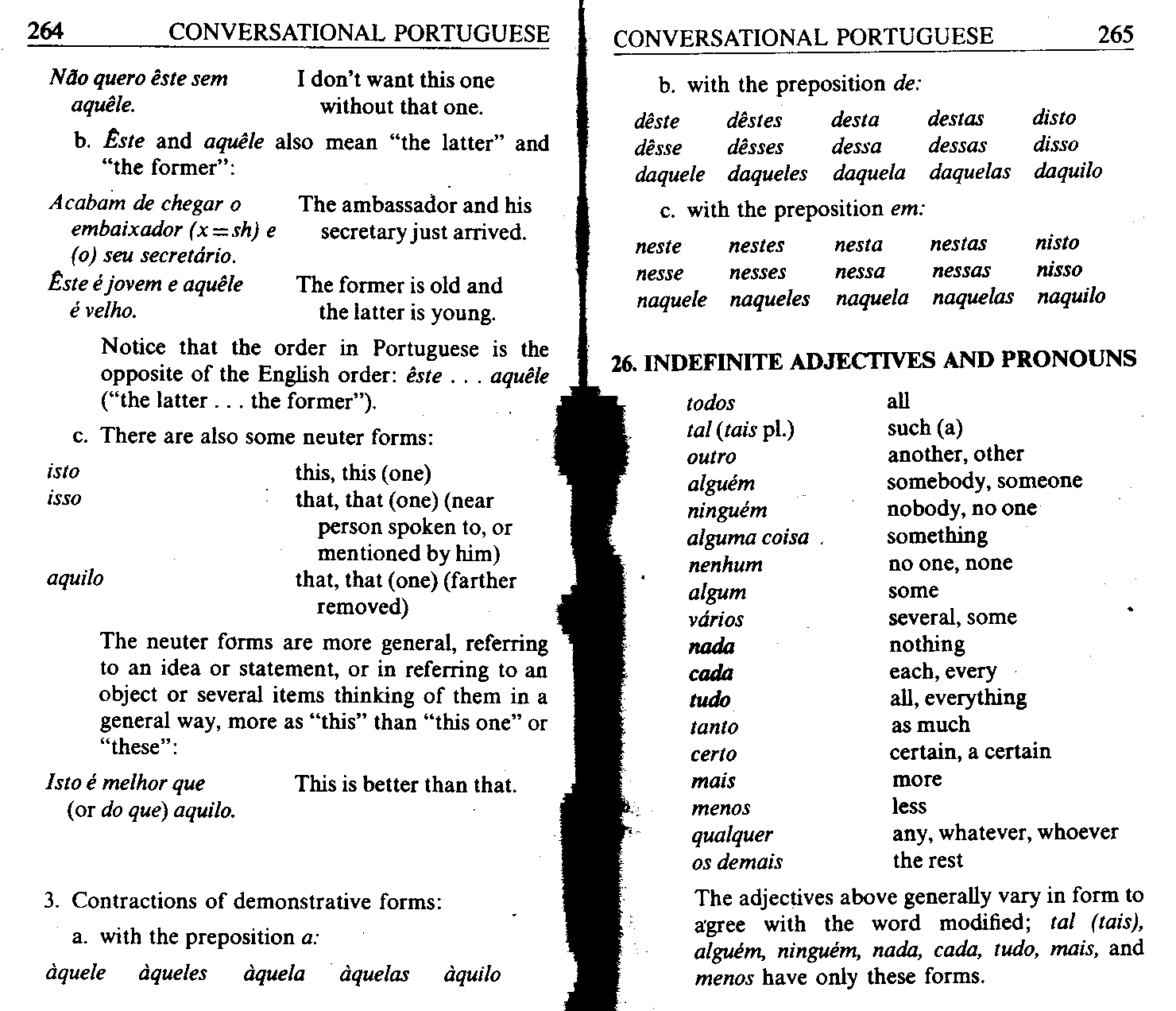Summary p264

264 CONYERSATIONAL PORTUGUESE
Ndo ąuero este sem I don’t want this one aąuele. without that one.
b. Este and aąuele also mean “the latter” and “the former”:
Acabam de chegar o The ambassador and his embaixador (x—sh) e secretaryjust arrived.
(o) seu secretario.
Este e jovem e aąuele The former is old and
e velho. the latter is young.

Notice that the order in Portuguese is the opposite of the English order: este . . . aąuele (“the latter ... the former”),
c. There are also some neuter forms:
|
isto |
this, this (one) |
|
isso |
that, that (one) (near |
|
person spoken to, or | |
|
mentioned by him) | |
|
aąuilo |
that, that (one) (farther |
removed)
The neuter forms are morę generał, referring to an idea or statement, or in referring to an object or several items thinking of them in a generał way, morę as “this” than “this one” or “these”:
Isto i melhor ąue This is better than that.
(or do ąue) aąuilo.
3. Contractions of demonstrative forms: a. with the preposition a: aąuele dąueles aąuela aąuelas aąuilo
b. with the preposition de:
|
deste |
destes |
desta |
destas |
disto |
|
desse |
desses |
dessa |
dessas |
disso |
|
daąuele |
daąueles |
daąuela |
daąuelas |
daąuilo |
|
c. with the preposition em: | ||||
|
neste |
nestes |
nesta |
nestas |
nisto |
|
nesse |
nesses |
nessa |
nessas |
nisso |
|
naąuele |
naąueles |
naąuela |
naąuelas |
naguilo |
26. INDEFINITE ADJECTIYES AND PRONOUNS
all
todos
tal (tais pl.)
outro
alguem
ninguem
ałgumacoisa .
nenhum
algum
ydrios
nada
coda
tudo
tanto
certo
mais
menos
ąualąuer
os demais
such (a) another, other somebody, someone nobody, no one something no one, nonę some
several, some nothing each, every all, everything as much
certain, a certain
morę
less
any, whatever, whoever the rest
The adjectives above generally vary in form to agree with the word modified; tal (tais), alguśm, ninguem, nada, cada, tudo, mais, and menos have only these forms.
Wyszukiwarka
Podobne podstrony:
Summary p266 266 CONYERSATIONAL PORTUGUESE27. NEGATION 1. Ndo “not” comes before
Summary p298 298 CONYERSATIONAL PORTUGUESE IMPERATIYE I Familiar (Fala) (tu)! (Falai) (vós!) (Ndo
Summary p222 222 CONYERSATIONAL PORTUGUESE 21. Vamos_(to have dinner). a. jantar
Summary p224 224 CONYERSATIONAL PORTUGUESE (3) variations occur in different areas: a.
Summary p226 226 CONYERSATIONAL PORTUGUESH CONYERSATIONAL PORTUGUESE 227 d g g h j I I Ut m as d i
Summary p230 230 CONYERSATIONAL PORTUGUESE 3, The cedilla (cedilha) is used with
Summary p234 234 CONYERSATIONAL PORTUGUESE k. with parts of the body and articles of clothing inst
Summary p236 236 CONYERSATIONAL PORTUGUESE De and em combine with the demonstrative forms (see GS2
Summary p238 238 CONYERSATIONAL PORTUGUESE 13. MASCULINE AND FEMININE 238 CONYERSATIONAL PORTUGUES
Summary p240 240 CONYERSATIONAL PORTUGUESE 14. THE PLURAL 1. Nouns ending in a vowel, including na
Summary p242 242 CONYERSATIONAL PORTUGUESE seu can also be used to translate “his,” “her,” “their.
Summary p246 246 CONYERSATIONAL PORTUGUESE 1«. COMPAR1SON 1. Rcgular comparison facil easy ma
Summary p248 248 CONYERSATIONAL PORTUGUESE 19. PRONOUNS Pronouns have varying forms depending on w
Summary p250 250 CONYERSATIONAL PORTUGUESE CONYERSATIONAL PORTUGUESE_ 251 (te) I
Summary p254 254 CONYERSATIONAL PORTUGUESE Nao me escreva mais. Eles decidiram que nos mandar
Summary p256 256 CONYERSATIONAL PORTUGUESE 21. SOME CONJUNCTIONS ainda que assim que ate
Summary p258 258 CONYERSATIONAL PORTUGUESE 23. ADYERBS 1. Some Portuguese adverbs are formed by ad
Summary p260 260 CONYERSATIONAL PORTUGUESE la (acold) there (morę remote) adiante . forward,
Summary p262 262 CONYERSATIONAL PORTUGUESE sabdo soap sabonete a cake of toilet
więcej podobnych podstron